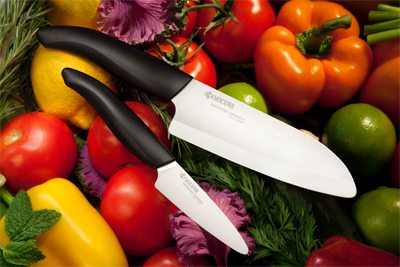|
Ceramic Knives by Kyocera are perfect for general applications requiring superior edge retention or wear resistance. Kyocera knives are preferred by professional cooks and home chefs alike, our ceramic knives, slicers and peelers won’t brown foods or transfer a metallic taste or smell, so your creations will always look and taste the way they should – fresh. CARE & USE: Ideal for straight cuts of fruits, vegetables and boneless meats. Always use with a wood or plastic cutting board. Hand wash, rinse & wipe (use a mild bleach solution for blade discoloration). Store in knife block, sheath or cutlery tray. AVOID: Avoid cutting foods with heavy rinds such as squash, pumpkin, pineapples and hard melons, nuts, roots, block cheese and frozen foods. Avoid carving, prying and boning. These applications involve twisting and flexing, which require a more flexible material than ceramic. Dropping on hard surfaces including in the sink. Hitting against china or flatware. Avoid putting in the dishwasher, hand washing recommended. Putting the blade in open flame (ceramic conducts heat). Scraping hard surfaces. Turning the blade on its side to smash garlic or other items. Avoid cutting on marble, glass, plates or tile. Applying force to the side of the blade. STORAGE: Store in a knife block / sheath / tray or on a dish drain. Use care when storing and removing the knife from a knife block to avoid tip damage. Storing any knife upright (sharp edge up) or sideways in a knife block reduces wear to the knife edge. WEAR: All knives dull over time. A soft metal blade (stainless steel) “rolls” as it becomes dull. Harder metals (such as high carbon steels, titanium, or carbide) hold their edge longer, but dull differently. As the material hardens, it becomes less forgiving and tends to slightly chip instead of roll. Advanced ceramic blades are simply the next and final step on this hardness scale as it is harder than any metal. Ceramic starts out sharper--and stays sharper--longer. In time, you may notice micro abrasions or nicks on the blade’s edge. This is the normal process by which any hard material blade will dull. The existence of microchips does not necessarily mean the knife is dull. You will find that it performs well for quite some time. When the knife becomes too dull to use, Kyocera’s sharpening process will “flatten out” the edge of the blade (removing all chips) and then reestablish a new sharp edge. Larger chips and broken tips can often be corrected by sharpening as well. |
|
Knife SharpeningDrop off service available at
3418 Hill Avenue and 370 Albert Street N. Please ensure your knives are properly protected during transportation to and from our shops. | ||||||






